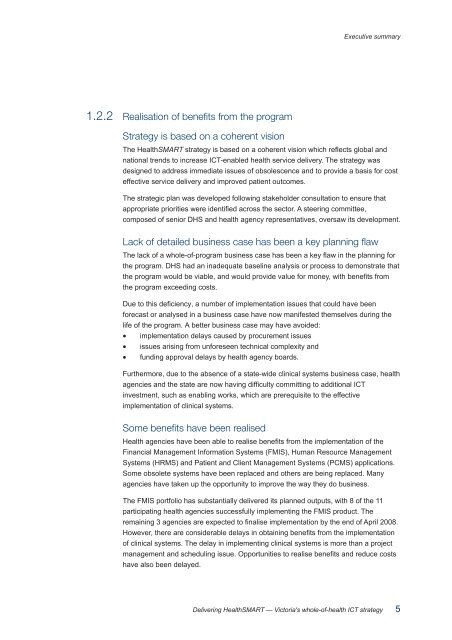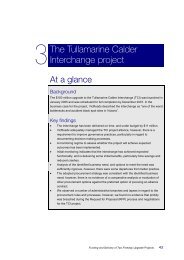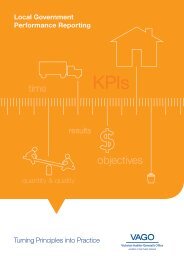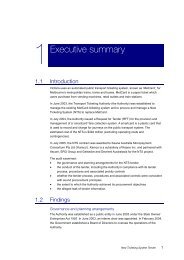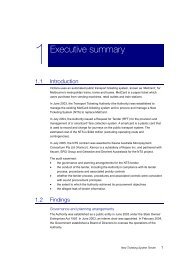Delivering HealthSmart Report - VAGO
Delivering HealthSmart Report - VAGO
Delivering HealthSmart Report - VAGO
You also want an ePaper? Increase the reach of your titles
YUMPU automatically turns print PDFs into web optimized ePapers that Google loves.
1.2.2 Realisation of benefits from the program<br />
Strategy is based on a coherent vision<br />
Executive summary<br />
The HealthSMART strategy is based on a coherent vision which reflects global and<br />
national trends to increase ICT-enabled health service delivery. The strategy was<br />
designed to address immediate issues of obsolescence and to provide a basis for cost<br />
effective service delivery and improved patient outcomes.<br />
The strategic plan was developed following stakeholder consultation to ensure that<br />
appropriate priorities were identified across the sector. A steering committee,<br />
composed of senior DHS and health agency representatives, oversaw its development.<br />
Lack of detailed business case has been a key planning flaw<br />
The lack of a whole-of-program business case has been a key flaw in the planning for<br />
the program. DHS had an inadequate baseline analysis or process to demonstrate that<br />
the program would be viable, and would provide value for money, with benefits from<br />
the program exceeding costs.<br />
Due to this deficiency, a number of implementation issues that could have been<br />
forecast or analysed in a business case have now manifested themselves during the<br />
life of the program. A better business case may have avoided:<br />
• implementation delays caused by procurement issues<br />
• issues arising from unforeseen technical complexity and<br />
• funding approval delays by health agency boards.<br />
Furthermore, due to the absence of a state-wide clinical systems business case, health<br />
agencies and the state are now having difficulty committing to additional ICT<br />
investment, such as enabling works, which are prerequisite to the effective<br />
implementation of clinical systems.<br />
Some benefits have been realised<br />
Health agencies have been able to realise benefits from the implementation of the<br />
Financial Management Information Systems (FMIS), Human Resource Management<br />
Systems (HRMS) and Patient and Client Management Systems (PCMS) applications.<br />
Some obsolete systems have been replaced and others are being replaced. Many<br />
agencies have taken up the opportunity to improve the way they do business.<br />
The FMIS portfolio has substantially delivered its planned outputs, with 8 of the 11<br />
participating health agencies successfully implementing the FMIS product. The<br />
remaining 3 agencies are expected to finalise implementation by the end of April 2008.<br />
However, there are considerable delays in obtaining benefits from the implementation<br />
of clinical systems. The delay in implementing clinical systems is more than a project<br />
management and scheduling issue. Opportunities to realise benefits and reduce costs<br />
have also been delayed.<br />
<strong>Delivering</strong> HealthSMART — Victoria's whole-of-health ICT strategy 5


